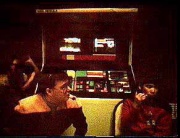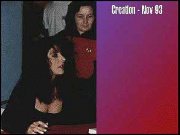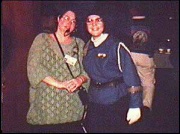User:Rjohnson/CSC
m (→Communication) |
m (→The Team Commander) |
||
| Line 101: | Line 101: | ||
Depending on the size of the convention and number of Tactical channels in use, the Commander may wish to keep a Command Assistant designated to monitor the tactical channels for the Commander, as well as other delegated tasks. | Depending on the size of the convention and number of Tactical channels in use, the Commander may wish to keep a Command Assistant designated to monitor the tactical channels for the Commander, as well as other delegated tasks. | ||
| + | <br><br> | ||
== Tools For Command == | == Tools For Command == | ||
Revision as of 00:47, 19 January 2006
Convention Security Command
This is a work sheet for a possible "Convention Security Command" (CSC) course of study. This program is a simplified version of a typical Fire Ground Command program used by multiple Fire Rescue Services across the United States.
This program would be useful for anyone interested in advancing into the management ranks of any job where they might be in charge of 3 or more "units" (individuals, teams, departments, etc), whether it be Convention Security, Middle or upper management of a Fan Organization,Management of a small business, Management within a Corporation, or simply management of a large family. [Grin]
Some of the topics to be covered are as follows:
Contents |
Span of Control
A term now used commonly in business management, span of control describes the number of subordinates that report to each manager (or to each military officer), originated in military organization theory. Theories about the optimum span of control go back to V.A. Graicunas In 1933. He used assumptions about mental capacity and attention span to develop a set of practical heuristics. In 1956, L.F. Urwick developed a theory based on geographical dispersion and the need for face-to-face meetings. Many Municipal Fire Departments have successfully used this theory to combat both Structural and "Brush" fires.
In Business organizations of the past, it was not uncommon to see average spans of 1 to 10 or even less. That is, One Manager supervising Ten Department Supervisors, Team Leaders, or Employees. on average. In the 1980s there was a flattening of organizational structures causing average spans to move closer to 1 to 100, made possible by the introduction of inexpensive information technology that replaced many middle managers. This may be great for the Corporate World, but not in Tactical Organizations, such as Police, Fire, EMS and Military Combat Teams, where constant changes may necessitate immediate changes in Strategy. These organizations work on the theory of One Manager for every Three to Seven subordinates, with a 1:5 ratio (One to Five) being considered Optimal.
So... What does Span of Control have to do with running a Security Team for a convention? Nothing, if everything runs like a well tuned watch and goes according to plan... But when one thing starts to go wrong, usually everyone needs the Team Commander Now and one person can only handle 3 to 5 emergencies at one time.
As you'll see in the section on Sectoring, depending on how many Sectors (Teams) you are using, once you reach more than 5 to 7 Teams, you MIGHT want to consider appointing an Assistant (or two) to divide up the number of Teams (3 or 4 each) watch over them, so you can focus on the "Big Picture" and keep yourself available for Special Situations and problem solving.
The Flow Charts below will illustrate the Span of Control differences between a Small and a Large Convention.
Chart 1:
All Teams Report Directly to the Team Commander
| Team Commander |
| Registr. & Main Entrance | Dealer Room / Secondary Exit Roving Team | Main Room Team: 1 In/1 Out |
Chart 2
Teams Report to the Assistant TCs, The Assistant TCs Report to the Team Commander
| Team Commander |
| Assistant TC 1 | |||
| Registr. | Main Gate | Roving Hall Team | Secondary Exit Guards |
| Assistant TC 2 | |||
| Event Room Guards | Dealer Room Team | Event Room Roving Team | Escort Team |
Sectoring
A Sector is defined as being "a part of the whole". Sectoring, in a combat sense of the term, would be the logistical subdivision and delegation of resources of a larger Area into smaller areas or Zones.
In the fire service, Command will designate sectors according to which side of the structure manpower is assigned (ie: going clockwise from the front of the house, Left Side, Rear, and Right Side of the house.) and designate them as Sectors A, B, C and D, accordingly. In some instances, people simply take a floor plan, draw lines on the floor plan and sector the area according to the delineations.
Many conventions aren't that simple. One thing we can do with Conventions, in order to make Sectoring work for us, is to substitute the word "Team" for the word "Sector". The main principles still apply.
Some suggestions of Convention Teams (Sectors) are:
- Command Post (CP) (with assistants, if needed)
- Registration: Works with Registrar and Cashier as needed
- Main Entrance (may be combined with Registration)
- Dealer Rooms: Roving Security, 1 Team per Room
- Event Room Guards: Stationary Guards at the Room's main entrance and secondary exits where Customers require special entry Passes/Tags/Wrist Bands.
- Event Room Team: Optional Inside Roving Patrol of the room(s) where the Highlight Activities will happen. May not be needed for smaller rooms, or may replace the secondary exit guards.
- Roving Patrol: Touring the hallways and checking Secondary Exits.
- Escort Team: The team assigned to the Celebrity Guests.
- Relief Teams: Roving Team to allow other Teams a rest break.
Obviously, this list of suggested Teams (Sectors) may be Expanded upon, or condensed and combined as necessary, in order to fit the situation of the Convention and a comfortable Span of Control.
Communication
With Face to Face communication seldom being an option for teams to report in, the use of Multi-Channel Radios to communicate important information has become the norm for security teams. Since the advent of the Multi-Channel FRS (Family Radio System), expensive and bulky One or Two Channel Portable Radio Systems are no longer a major expense for Security Teams. With many families now using FRS radios, one logistical problem may be finding enough unused channels to designate as Administrative and Tactical Channels.
As in Combat situations, Brief, Clear and Concise reporting is essential to any security operation. Transmissions themselves, should be kept short and idle chatter should be avoided during busy portions of the convention day.
- The Administration (Admin) Channel: The Main Channel used by the Team Commander for Key Transmissions. This channel would be used to initiate reports to the Team Commander, or for Emergency transmissions. If the communication is going to require more than a few brief transmissions, the Team Commander MAY request that the report/conversation move to a secondary Tactical (Tac) Channel.
- The Tactical (Tac) Channels: Two or more Secondary Channels utilized by the various Security Teams which allow the team members to communicate within the team, without "Stepping" on other teams' transmissions, or cluttering the Admin Channel.
Each Station, or Team, should be able to communicate with the Team Commander's Admin Channel, as well as a Secondary Tactical Channel. Each Roving Team consisting multiple members should have their own designated Tactical Channel, for intra-team communication. The number of Tactical Channels required will depend several factors:
- The Size of the Convention: The number of rooms/stations requiring direct communication with the Command Post
- The number of Convention Security Teams available and, of course...
- The number of available Radios and Channels to actually work with.
The Team Commander
The Team Commander needs to be able to multi-task, as he'll be coordinating with the Host Facility's Security Chief and Event Coordinator, The Convention's Owner/Coordinator, as well as his Security Stations (Registration/Main Entrance, Dealer/Event Exits), Team Leaders and Team Members.
The Team Commander should try to:
- Centrally locate himself where there will be easy access to either the Facility's Security Chief, or Event Coordinator for periodic face-to-face interaction.
- Be located somewhere they can have a good over-all view of the Convention Scene.
- Have easy access to a "Hard Line" phone that may be easily traced in an emergency (ie: 911 calls, intra-facility calls & call-backs, etc.)
- Periodically touch base with the Convention Coordinator (may be either the owner of the Con, or his Designee) to make sure the Schedule you and your Teams have is Up-To-Date and accurate. Since Conventions sometimes need to rearrange time slots, or the Schedule as a whole, This may keep your Team from being Embarrassed because they're at the Wrong Location at the Wrong Time.
Depending on the size of the convention and number of Tactical channels in use, the Commander may wish to keep a Command Assistant designated to monitor the tactical channels for the Commander, as well as other delegated tasks.
Tools For Command
The most important tool any Team Commander needs to keep with them is Information.
The Team Commander should keep the following information readily available:
- Contact Phone Numbers for the Facility's Key Employees: the Event Coordinator and Head of Security, as well as any other Facility employees that the Event Coordinator feels you should need (maint., A/V, other things that you'll need to relay to the Convention Coordinator).
- Contact Emergency Numbers (Rescue, etc), if not routed through one of the Facility Employees.
- An Up-To-Date copy of the Convention Schedule to be used for scheduling Event Teams. Check on changes several times throughout the day, as well as at the END of each Day, to prepare for the NEXT day.
- A List of Security Stations and Event Locations being staffed, along with their Assigned Tac Channel (if multiple channels are necessary) and an updated roster of Who is manning each Station/Team.
- An Over-All Roster of volunteers, showing the Days & Times they volunteered for, Back-up volunteers to Fill-In any gaps, as well as volunteers to be utilized for Relief Breaks.
Managing Manpower
This may be the toughest problem for the Team Commander to deal with. Obviously, you'll be tempted to give your friends some choice Security assignments. It may also seem obvious to place the Biggest, Meanest person you know at the entrances & exits, but you NEED to be as objective as possible when making staffing assignments.
As mentioned in other Security Courses, we as civilian volunteers, do not have any power or authority to arrest & detain, unless the Facility's Security Chief gives us that Authority. Placing "Moose" at the Main Hall's Entrance MAY not be your best choice, should a customer get rowdy and "Moose" starts getting irritated.
What "type" of person to stage where:
- Team Members assigned to main Entrances & Exits need to be able to reason with customers calmly and rationally, while simultaneously requesting assistance.
- If you utilize someone in a Bulky Costume such as Klingon Battle Dress, the extra "warmth" generated by the costume could cause drowsiness. These Staffers either need to be assigned to an "active", Roving position, or be given breaks frequently if they are at a Stationary Post. There's nothing Funnier (and more annoying) than seeing a Klingon Falling asleep at their post. (Grin)
- When staffing Celebrity Escort, you need to steer away from utilizing anyone who is more interested in being next to a star, than they are in staying alert and doing their job. If the ONLY thing a staffer and talk about is "Getting to see Ensign Buxom from episode 130", this should throw up a Red Flag to the Team Commander.
Many otherwise "Normal" staffers tend to become "star-struck" when faced with a celebrity for the 1st time. One way to overcome this potential problem would be to see if the Escorts might have some "behind the Scenes" time prior to the Celebrity actually taking the stage. Many times, being able to have some time with the celebrity before hand, even if it's simply standing in the background during a local TV interview, or standing in on a briefing is all that's needed. Many celebrities are willing to have a "closed" question & answer period with Convention Staffers. It sometimes gives them a chance to reminisce and "warm up" before the real show.
Putting It All Together
(work in progress)
Utilizing Sectoring, in conjunction with Span of Control, the CSC may deploy Security Individuals (or teams) to various areas of the Convention facility by predetermined Sectors.


